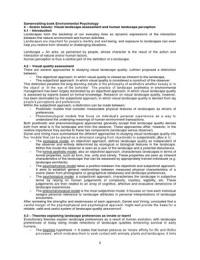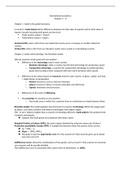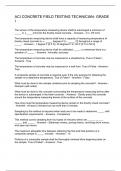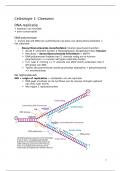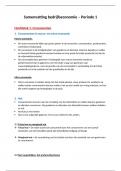4 – Scenic beauty: Visual landscape assessment and human landscape perception
4.1 – Introduction
Landscapes form the backdrop of our everyday lives as dynamic expressions of the interaction
between the natural environment and human activities.
Landscapes are important for people’s identity and well-being, and exposure to landscapes can even
help you restore from stressful or challenging situations.
Landscape = An area, as perceived by people, whose character is the result of the action and
interaction of natural and/or human factors.
Human perception is thus a central part of the definition of a landscape.
4.2 – Visual quality assessment
There are several approaches to studying visual landscape quality. Lothian proposed a distinction
between:
− The objectivist approach: In which visual quality is viewed as inherent to the landscape.
− The subjectivist approach: In which visual quality is considered a construct of the observer.
This distinction parallels the long-standing debate in the philosophy of aesthetics whether beauty is ‘in
the object’ or ‘in the eye of the beholder’. The practice of landscape aesthetics in environmental
management has been largely dominated by an objectivist approach, in which visual landscape quality
is assessed by experts based on formal knowledge. Research on visual landscape quality, however,
has been dominated by the subjectivist approach, in which visual landscape quality is derived from lay
people’s perceptions and preferences.
Within the subjectivist approach, a distinction can be made between:
− Positivistic models that consider measurable physical features of landscapes as drivers of
preferences.
− Phenomenological models that focus on individual’s personal experiences as a way to
understand the underlying meanings of human-environment transactions.
Both positivistic and phenomenological approaches generally accept that landscape quality derives
both from what is in the landscape and from the observer. These approaches differ, however, in the
relative importance they ascribe to these two components (landscape versus observer).
Daniel and Vining have summarised the different approaches to studying visual landscape quality into
five ‘models’ that can be placed on a dimension ranging from objectivistic to subjectivistic (Box 4.1):
− The ecological model, an objectivist approach, defines landscape quality as independent of
the observer and entirely determined by ecological or biological features in the landscape.
Within this model the observer is seen as a user of the landscape and a potential disturbance.
− The formal aesthetic model, also an objectivist approach, characterises landscapes in terms of
formal properties, such as form, line, unity and variety. These properties are seen as inherent
characteristics of the landscape that can be assessed by appropriately trained individuals (e.g.
landscape architects).
− The psychophysical model takes a position between the objectivist and subjectivist approach.
It aims to establish general relationships between measured physical characteristics of a
scene (taken from photographs or geographical databases) and landscape preferences.
− The psychological model, a subjectivist approach, characterises the landscape in subjective
terms by relying on human judgements of complexity, mystery, legibility, etc. These
judgements are then related to an array of cognitive, affective and evaluative dimensions of
landscape experiences.
− The phenomenological model is the most subjectivist model. It focuses on how each individual
assigns personal relevance to landscape attributes in personal interpretations of landscape
encounters.
After reviewing the strengths and weaknesses of each approach, Daniel and Vining, concluded that a
careful merger of the psychophysical and psychological approach ‘might well provide the basis for a
reliable, valid and useful system of landscape-quality assessment’.
4.3 – Theories explaining landscape preferences as innate or learnt
Evolutionary theories explain landscape preferences as a result of human evolution, with landscape
preferences of today being innate reflections of landscape qualities enhancing survival in early
humans.
− The biophilia hypothesis It states that human possess an ‘innate affinity for life and lifelike
processes’, which motivates them to seek contact with animals, plants and landscapes. It links
1
, diversity of species and landscape types to optimal human functioning, but does not specify
which species or landscape types comply best with people’s biophilic needs.
− The habitat theory It states that humans have an innate preference for savannah-like
environments, as this was a suitable habitat for our ancestors. This theory explains
environmental preferences as the results of the search for a suitable habitat.
− The prospect-refuge theory of Appleton Focusing on the role of early humans as both
predator and prey, thus needing to see (prospect) without being seen (refuge). According to
Appleton, the presence of prospect and refuge in a landscape was favourable to survival in
primitive human communities, which is still reflected in contemporary landscape preferences.
− Finally, the preference matrix developed by Rachel and Stephen Kaplan is probably the most
quoted psychological theory explaining landscape preferences. Building on insights from
prospect-refuge theory, this theory specifies two basic human needs that influence landscape
preferences: the need for exploration and the need for understanding.
Box 4.2: The preference matrix (page 41)
For pre-humans who depended on hunting and gathering, the spatial understanding of the areas they
inhabited as well as the ability to explore new areas was probably highly important. Building on these
insights, Kaplan and Kaplan proposed that visual information facilitating understanding and exploration
has been very important in shaping human preferences, because appreciation of such landscapes
would have been favoured by natural selection. The preference matrix combines these two
informational needs with two different levels of immediacy or the degree of inference that is required in
extracting the information (two-dimensional versus three-dimensional space). The resulting matrix, as
depicted in figure 4.1, identifies four landscape characteristics predicting landscape preference:
− Coherence: Immediate understanding of how elements in the environment fit together.
− Complexity: Visual richness that can be immediately explored.
− Legibility: Understanding of what lies ahead and how you could find your way and not get lost.
− Mystery: The promise of new things to explore if moving further into the landscape.
In a review of preference studies they found mystery to be the most consistent predictor of landscape
preference.
Figure 4.1: The preference matrix (page 41)
Informational needs
Level of interpretation Understanding Exploration
Immediate (2-dimensional) Coherence Complexity
Inferred (3-dimensional) Legibility Mystery
In contrast to the evolutionary approaches, cultural theories explain preferences as learnt and
shaped by social, cultural and personal characteristics. These theories often emphasise cognitive
evaluation of functions offered by the landscape to individuals, instead of immediate affective
responses. Much quoted cultural theories include topophilia and the ecological aesthetic. Topophilia
implies that humans have a tendency to bond with what one knows well, meaning that familiarity and
experience are important drivers of landscape preference. The ecological aesthetic states that
knowledge about the ecological functions of a landscape will lead to preference for it, making
knowledge an important driver of preference. Other cultural theories include theories of sense or spirit
of places, also known as genius loci, emphasising the uniqueness and visually striking features of
landscapes, landscape heritage approaches emphasising visual signs of cultural heritage and
aesthetics of care emphasising the importance of signs that a landscape is taken care of.
Consistent with evolutionary theories, empirical research has shown a high degree of universality in
landscape preferences. However, these evolutionary-based preferences are modified and shaped by
cultural influences and experience, resulting in variations in preference ratings between groups and
subcultures. Some landscape elements, such as water, seem to be rather universally appreciated
whilst other aspects such as openness are evaluated differently according to observer characteristics.
These findings underline the importance of developing integrated theories that combine evolutionary,
cultural and personal bases for landscape preferences.
4.4 – Measuring and mapping scenic beauty
Several methods and framework for the assessment of scenic beauty and landscape quality have
been developed to provide tools for decision support and landscape monitoring. Such methods and
frameworks should be transparent, repeatable and transferable between landscapes.
2
, − The scenic beauty estimation (SBE) method is a psychological method developed by the US
Forestry Department. The SBE method estimates scenic beauty judgements for (images of)
various natural scenes. These judgements are then statistically related to measurable
landscape characteristics through regression analysis. The relationship between measurable
landscape characteristics and perceived scenic beauty is used to predict or evaluate
landscape management alternatives for their impact on scenic beauty. The SBE method has
been applied mostly to forest stands.
− The VisuLands framework, this framework links visual indicators to theories of landscape
perception and preference. It identifies nine key visual landscape aspects: naturalness,
stewardship, disturbance, historicity, visual scale, imageability, ephemera, coherence and
complexity. For each of these aspects, landscape attributes and elements contributing to its
expression in the visual landscape are identified, as well as currently used visual indicators to
assess it. The framework presents a comprehensive approach to describing visual landscapes
and assessing visual effects of landscape change using data sources such as photographs,
land cover data, airborne photographs and field observations. Research has identified strong
relationships between the nine key aspects and landscape preferences, although their relative
importance and interpretation may vary across groups.
4.5 – Methodological developments
The majority of landscape preference studies have used photographs as visual stimuli to assess
preference. On-site surveys are time consuming, and photographs have been found to be efficient and
valid representations of real landscapes. Recent developments include the use of computer
visualisations and virtual environments in landscape preference surveys and scenario assessments.
The use of virtual reality allows for a high degree of control over the environment while at the same
time ensuring a high immersion and realistic experience through motion and sound.
Another recent development is the possibility to project map-based data onto a 3D terrain to create
panoramic scenes of the visible area from certain points in the landscape, so-called viewsheds.
Eye tracking is a rather novel approach within landscape research, capturing the viewer’s exploration
of an image. Eye movements are recorded as the respondent assesses the landscape image on the
screen. Pupil size gives an indication of relaxation and arousal responses, which can give information
about the restorative potential of landscape elements.
5 – Health benefits of nature
5.2 – What is health and how can it be measured?
Traditionally, health has been defined in Western societies as the ‘absence of diseases’. This
definition is in line with the biomedical or pathogenic approach to health that conceptualises disease
exclusively as a biological process that is the result of exposure to a certain pathogen. By contrast, he
biopsychosocial or salutogenic approach to health sees health as a multidimensional concept that
involves not only biological but also psychological and social influences.
This approach focuses on identifying factors that promote health rather than on factors that cause
disease.
The biopsychosocial or salutogenic conception of health is reflected in the well-known definition of
health proposed by the World Health Organization (WHO): Health is a state of complete physical,
mental and social well-being and not merely the absence of disease or infirmity’. This definition is very
broad, so alternatively health is defined as ‘a condition of well-being free of disease or infirmity’.
The health status of an individual or group can be measured by means of health indicators. A
distinction can be made between clinical and public health indicators:
− Clinical health indicators cover objective and subjective measures of patient functioning, such
as symptom severity, mortality, hospital days, medication use, discomfort and patient
satisfaction.
− Public health indicators give an indication of the health status of a population. These indicators
include measures based on birth and death statistics, such as mortality rates and life
expectancy, measures of the prevalence and incidence of disease and illness, measures of
self-reported general, mental and physical health, and measures of health-related quality of
life. In addition to primary health indicators, health risk factors can be distinguished, which are
associated with an increased probability of disease occurrence in the future.
5.3 – What is nature and how can it be measured?
Because visual experience plays an important role in human-nature interactions, representations of
natural environments and features are also included in the concept of nature.
3


